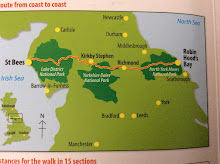
It is now mid March and we have started to prepare for our long walk along the VDLP at the beginning of May, a total distance of 1000k's.
This means regular walks carrying backpacks with some weight.
This week we have walked 8.42k's, 12.68k's, 19.83k's and yesterday 25.04k's.
WHY the VDLP?
It is 7 years since we walked the medieval pilgrim route from Le Puy in France to Santiago to Compostela in Spain and feel ready for our next challenge which we can combine with a visit to the historic cities of Granada, Cordoba and Seville.
WHEN By starting in early May we hope to finish the southern part before the hot summer weather is upon us and to arrive in Santiago de Compostela before the huge crowds descend at the end of July for Holy Year 2010.
WHERE We start walking from Seville and walk through Andalucia, Extramadura, the Meseta (often hot and lacking shelter) and then follow on through Galicia (often wet and cold) to reach Santiago by the end of June.
HOW We will average up to 24k's of walking per day and plan to stay in refugios (albergues) along the route. Our backpacks will carry all we need for the 8 weeks including a compact sleeping bag and bed roll for basic accommodation where there is only 'roof and floor'.
In some villages and towns we will choose small hostels, and occasional monasteries. In some of the bigger cities like Salamanca, we have pre-booked hotels so that we can refresh, explore city sights, enjoy local food and have time to meet the locals and practice our Spanish!
WHO will we meet along the route? This route is usually much quieter and more remote than the Camino Frances, but we expect lots of fellow pilgrims to be joining us this Holy Year (Walking in a Holy Year is very significant for the Spanish people and other Roman Catholics).
There is also plenty of opportunities to mix with the locals, probably more so in the smaller villages and rural communities.
Sometimes refugios are locked on arrival and so starts an often challenging hunt for the key, often with the local Mayor, but sometimes with the senora at the grocery shop (tienda de ultramarinos) which in itself can be tucked away behind someone's house.
We would also have opportunities to attend special pilgrim services and evening vespers in cathedrals and monasteries along the way, so meeting priests and monks attached to these communities.
WHAT are some of the highlights we can expect to see and do along the route?
- The Alhambra in Granada.
- The beautiful candy-striped Mesquita in Cordoba.
- The annual festival Los Patios Cordobeses begins while we are in Cordoba, so we hope to visit some of these beautiful private courtyards usually not open to the public.
- The Cathedral in Seville and the famous Giralda Tower.
- Roman bridges, ruins and roads.
- Roman thermal baths.
- A village which is the sausage and ham capital of Spain.
- A village which has been famous for its artisan breads for 700 years.
- A walled town which has a annual festival where women 'run with the cows' within the city walls.
- Spend a night or two with monks (one of the monasteries also looks after disabled and homeless men).
- Enjoy local sherry and tapas.
- Walk through areas of grazing pigs and plentiful vineyards.
- Walk along droving roads.
- See masses of spring flowers.
- Festivals where local dress up and are allowed to hit onlookers with sticks!
- Another village known as the cheese capital of spain.....its specialty is a very runny sheeps cheese.
- Possibility of seeing or hearing hunters of wild fox, boar or wolves.
- Villages where the townspeople serenade the bride, groom and the best man on the eve of their wedding.
- Villages with medieval humpback bridges, and famous for chestnut wood carvings.
- Villages where you will see the elderly scurrying past in their robes, heading for therapy in the thermal baths.
- A small city which has 7 city walls!
- Lots of dovecotes (palomares). Pigeons have been used for centuries to provide fertilizer and food.
- Underground wine cellars (bodegas) carved out of the mud.
- Villages with wooden carts and adobe brick houses.
- Albergues in mayoral offices where the washing is hung out on the balcony of the Town Hall next to the flags.
- Tiny churches built by Templar Knights.
- Small villages with people living on the top floor of their simple dwellings and the livestock underneath.
- Raised granaries (horreos) used for centuries for storing grain and keeping out the rats and mice.
- A small village with the best bagpipe band in Galicia.
- A monastery open to pilgrims, where the monks boast that they have bears for neighbours, and their specialty is cream cheese and hot chocolate.
- Old communal lavaderos (outdoor washing facilities in a village) which pilgrims can use.
- We plan to finish our walk at Cape Finisterre and enjoy the sunset with seafood at one of the famous open air sardine grills on the harbour.

No comments:
Post a Comment